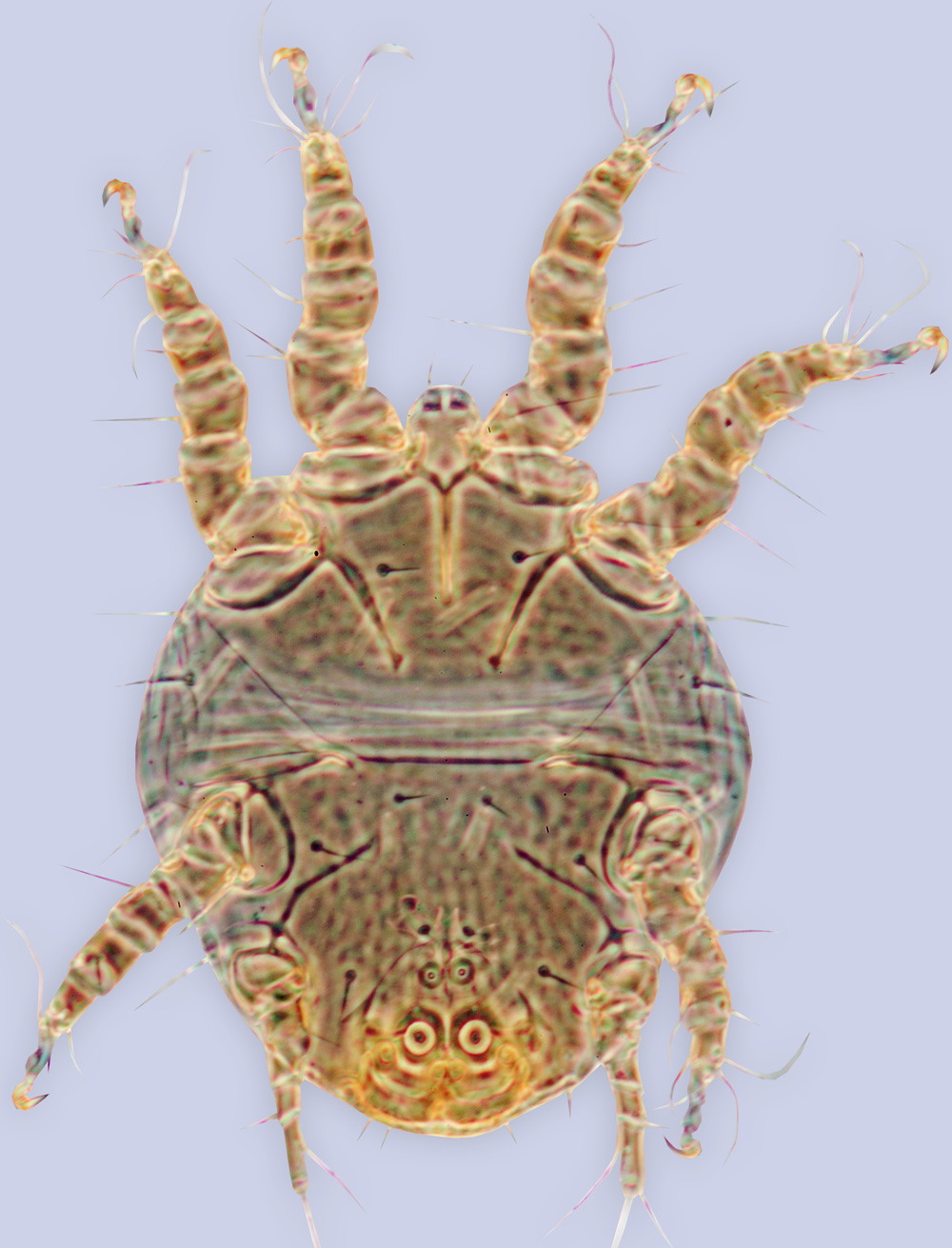Bee Mites : Acari : Acariformes : Sarcoptiformes : Chaetodactylidae : Chaetodactylus
Chaetodactylus ludwigi (Trouessart, 1904)
Trichotarsus Ludwigi Trouessart, 1904a: 234, Figs a, a' (holotype not designated, syntypes in MNHN and ZSMC (Fain & Pauly, 2001); description of inert HDNs, mention of presence of feeding instars and two forms of HDNs. Erroneously stated that immobile HDN has female external genital organs and is inseminated by adult males); Ludwig, 1904: 216, Figs a, a’ (review of Trouessart’s (1904a,b) works where development of two deutonymphal forms of Ch. ludwigi and Ch. osmiae is discussed); Vitzthum, 1912b: 184 (mention of two deutonymphal forms, emendation of host name as as Lithurgus dentipes (=L. atratus); Vitzthum, 1919: 30
Trichotarsus ludwigi: Trouessart, 1904b: 365 (erroneously stated that immobile HDN has female external genital organs and is inseminated by adult males); Knülle, 1959: 385 (short note on leg morphology of inert HDN)
Tricholarsus Ludwigi [sic!]: Vitzthum, 1912d: 292
Chaetodactylus ludwigi: Zachvatkin, 1941: 42; Lith, 1957: 198; Baker, 1962a: 229; Fain, 1981b: 2 (stated that described insufficiently, tentative placement to subgenus Chaetodactylus); Baker, 1987: 65; OConnor, 1993a: 353; Pauly & Munzinger, 2003: 160; Klimov & OConnor, 2007: 826 (remark on morphology); Klimov et al., 2007a: 1371; Klimov & OConnor, 2008: 218 (notes on distribution of ludwigi-dalyi group, included in morphological phylogenetic analysis; included in key)
Chaetodactylus (Chaetodactylus) ludwigi: Fain & Pauly, 2001: 128, Figs 1-4, 18-21 (redescription of HDN; examining type series in MNHN and ZSMC; distinct groups different by sizes; SE pictures on host).
Material (show database records).
Hosts.
Lithurgus (Lithurgus) atratus Smith, 1853 (as Megachile lonalap) (Micronesia) [nest in trunk of Hibiscus ("Hybiscus") with pollen of this plant] (type host) (Trouessart, 1904a) (India, as Lithurgus dentipes, part.)) Fain & Pauly, 2001
Lithurgus pullatus Vachal, 1903 (Madagascar)
Lithurgus scabrosus (Smith, 1859) (Java; Moorea Is, near Tahiti; New Caledonia)
Distribution (show map). Federated States of Micronesia: Pohnpei Is. ("Carolines Islands: Ponapé") (type locality);
New Caledonia; French Polynesia: Moorea Is; Indonesia ("Java: Soekaboemi"); India; Madagascar (Fain & Pauly, 2001).
References
Baker, E. W. 1962. Natural history of Plummers Island, Maryland. XV. Descriptions of the stages of Chaetodactylus krombeini, new species, a mite associated with the bee, Osmia lignaria Say (Acarina: Chaetodactylidae). Proceedings of the Biological Society of Washington.75: 227-236.
Baker, E. W., D. W. Roubik & M. Delfinado-Baker. 1987. The developmental stages and dimorphic males of Chaetodactylus panamensis, n. sp. (Acari: Chaetodactylidae) associated with solitary bee (Apoidea: Anthophoridae). International Journal of Acarology.13: 65-73.
Fain, A. 1981. Notes on the hypopi of the genus Chaetodactylus Rondani, 1866 (Acari, Chaetodactylidae). Bulletin de l'Institut Royal des Sciences Naturelles de Belgique Entomologie.53: 1-9.
Fain, A. & A. Pauly. 2001. Notes on phoretic deutonymphs of mites (Acari) associated with Old World Megachilidae and Anthophoridae (Insecta Hymenoptera), mainly from Madagascar 1. Families Chaetodactylidae, Acaridae, Histiostomatidae and Winterschmidtiidae (Astigmata). Belgian Journal of Entomology.3: 125-142.
Klimov, P. B. & B. M. OConnor. 2007. Ancestral area analysis of chaetodactylid mites (Acari: Chaetodactylidae), with description of new early derivative genus and six new species from the Neotropics. Annals of the Entomological Society of America.100: 810-829.
Klimov, P. B. & B. M. OConnor. 2008. Morphology, evolution, and host associations of bee-associated mites of the family Chaetodactylidae (Acari: Astigmata), with a monographic revision of North American taxa. Miscellaneous Publications Museum of Zoology University of Michigan.199: 1-243.
Klimov, P. B., B. M. OConnor & L. L. Knowles. 2007. Museum specimens and phylogenies elucidate ecology' s role in coevolutionary associations between mites and their bee hosts. Evolution.61: 1368-1379.
Knülle, W. 1959. Morphologische und entwicklungsgeschichtliche Untersuchungen zum phylogenetischen System der Acari: Acariformes Zachv. II. Acaridiae: Acaridae. Grundlagen der Getreidemilben—Systematik. Mitteilungen aus dem Zoologischen Museum in Berlin.35: 347-418.
Lith, J. P. v. 1957. On the behaviour of Chaetodactylus mites (Acar., Tyr.) in the nests of Osmia rufa L. and Chelostoma florisomne (L.) (Apidae, Megachilidae). Entomologische Berichten.17: 197-198.
Ludwig, F. 1904. Trouessart, E. L. Über zweierlei Hypopuslarven bei ein und derselben Milbenart. Naturwissenschaftliche Rundschau.19: 216-217.
OConnor, B. M. 1993. Generic relationships in the Chaetodactylidae (Acari: Astigmata) with description of a new genus. Acarologia.34: 345-362.
Pauly, A. & J. Munzinger. 2003. To the knowledge of Hymenoptera Apoidea from New Caledonia, with some informations on visited flowers. Annales de la Societe Entomologique de France.39: 153-166.
Trouessart, E.-L. 1904a. Deuxième note sur les hypopes du genre Trichotarsus. Comptes Rendus Hebdomadaires des Séances et Memoires de la Société de Biologie et de ses filiales, Paris.56: 365-366.
Trouessart, E.-L. 1904b. Sur la coexistence de deux formes d'Hypopes dans une mème espèce, chez les Acariens du genre Trichotarsus. Comptes Rendus Hebdomadaires des Séances et Memoires de la Société de Biologie et de ses filiales, Paris.56: 234-237.
Vitzthum, H. 1912a. Ueber einige auf Apiden lebende Milben. Zeitschrift für Wissenschaftliche Insektenbiologie.8: 179-184.
Vitzthum, H. 1912b. Ueber einige auf Apiden lebende Milben. Zeitschrift für Wissenschaftliche Insektenbiologie.8: 289-293.
Vitzthum, H. 1919. Acarologische Beobachtungen. 3. Reihe. Archiv für Naturgeschichte.85(Abt. A, no. 5): 1-62.
Zachvatkin, A. A. 1941. Tiroglifoidnue kleshchi Tyroglyphoidea [=Tyroglyphoid mites Tyroglyphoidea]. In Fauna SSSR: Paukoobraznuye, ed. S. A. Zernov, 475. Moscow-Leningrad: Akademiya Nauk SSSR.
B. OConnor and P. Klimov ©
Created: Jun 09, 2011
Last modified: 
